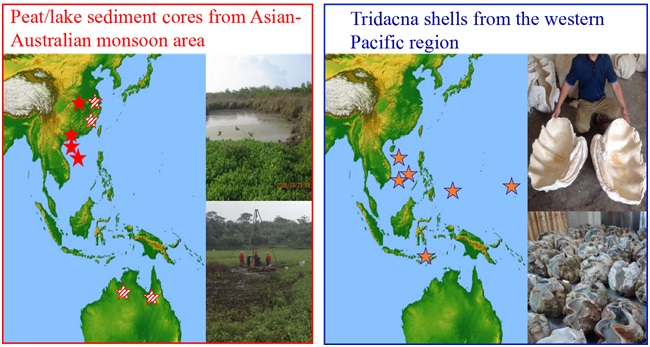Pollen and Tropical Climate Change Lab
Brief description
The Pollen Lab was established since 1994and Tropical Climate Change Lab was built in 2012. These two labs were combined to Pollen and Tropical Climate Change Lab in 2015. It is currently supervised by Prof. Hong Yan. A series of scientific articles have been recently published in Nature Geoscience, Nature Communications, Earth-Science Reviews, Quaternary Science Reviews, and many other well-known international journals. This Lab has been maintaining a close cooperation with many internal as well as oversea geological researchcenters including University of Science and Technology of China, University of Hong Kong, Fudan University, Harvard-Smithsonian Center for Astrophysics, Alfred Wegener Institute, University of Helsinki, Australian Nuclear Science and Technology Organization, and University of New South Wales. This Lab is now well-funded with many up-to-date equipments and softwares for performing Quaternary researches.
Research focuses
The Pollen and Tropical Climate Change Lab primarily focuses on using giant clam shells, sediment cores from peats and lakes for exploring the past climate changes in tropical-subtropical area. The Lab particularly aims to employ pollen and geochemical proxies for quantitatively reconstructing high-resolution temperature and hydrological changes during the late Quaternary in the Asian-Australian monsoon region, and their potential linkages with the internal and external forcings, such as the solar insolation, greenhouse gases, ice volume, sea level, North Atlantic climate changes, ENSO, ITCZ, and so on.
Research area and samples

Team members
Hong Yan (Professor)
John Dodson (Guest Professor)
Fengyan Lu (Assistant Professor)
Chengcheng Liu (Master Student)
Contact Information
Prof. Hong Yan
Tel: +86 29 62336240
E-mail: yanhong@ieecas.cn
Key publications
1. Yan, H., Wei, W., Soon, W., An, Z.S., Zhou, W.J., Liu, Z., Wang, Y., Carter, R.M. Dynamics of the intertropical convergence zone over the western Pacific during the Little Ice Age.Nature Geoscience, 8: 315-320, 2015.
2. Yan, H., Sun, L., Wang, Y., Huang, W., Qiu, S., Yang, C. A record of the Southern Oscillation Index for the past 2,000 years from precipitation proxies. Nature Geoscience, 4: 611-614, 2011.
3. Yan, H., Sun, L., Oppo, D.W., Wang, Y., Liu, Z., Xie, Z., Liu, X., Cheng, W. South China Sea hydrological changes and Pacific Walker Circulation variations over the last millennium. Nature Communications, 2: 293, 2011.
4. Yan, H., Soon, W., Wang, Y. A composite sea surface temperature record of the northern South China Sea for the past 2,500 years: A unique look into seasonality and seasonal climate changes during warm and cold periods. Earth-Science Reviews, 141: 122-135, 2015.
5. Yan, H., Shao, D., Wang, Y., Sun, L. Sr/Ca profile of long-lived Tridacna gigas bivalves from South China Sea: a new high-resolution SST proxy. Geochimica Et Cosmochimica Acta, 112: 52-65, 2013.
6. Yan, H., Shao, D., Wang, Y., Sun, L. Sr/Ca differences within and among three Tridacnidae species from the South China Sea: implication for paleoclimate reconstruction. Chemical Geology, 390: 22-31, 2014.
7. Yan, H., Sun, L., Shao, D., Wang. Y. Seawater temperature seasonality in the South China Sea during the late Holocene derived from high-resolution Sr/Ca ratios of Tridacna gigas. Quaternary Research, 83: 298-306, 2015.
8. Li, J.Y., Dodson,J., Yan, H., Wang, W.M., Innes, J.B., Zong, Y.Q., Zhang, X.J., Xu, Q.H., Ni, J., Lu, F.Y. Quantitative Holocene climatic reconstructions for the lower Yangtze regionof China. Climate Dynamics, in press, 2017.
9. Li, J.Y., Dodson,J., Yan, H., Zhang, D.D., Zhang, X.J., Xu, Q.H., Lee, H.F., Pei, Q., Cheng, B., Li, C.H., Ni, J., Sun, A.Z., Lu, F.Y., Zong, Y.Q. Quantifying climatic variability in monsoonal northern China over the last 2200 years and its role in driving Chinese dynastic changes. Quaternary Science Reviews, 159: 35-46, 2017.
10. Li, J.Y., Zhao, Y., Xu, Q.H., Zheng, Z., Lu, H.Y., Luo, Y.L., Li, Y.C., Li, C.H., Sepp?, H. Human influence as a potential source of bias in pollen-based quantitative climate reconstructions. Quaternary Science Reviews, 99: 112-121, 2014.
11. Li, J.Y., Xu, Q.H., Zheng, Z., Lu, H.Y., Luo, Y.L., Li, Y.C., Li, C.H., Sepp?, H. Assessing the importance of climate variables for the spatial distribution of modern pollen data in China. Quaternary Research, 83: 287-297, 2015.
12. Li, J.Y., Ilvonen, L., Xu, Q.H., Ni, J., Jin, L., Holmstr?m, L., Zheng, Z., Lu, H.Y., Luo, Y.L., Li, Y.C., Li, C.H., Sepp?, H. East Asian summer monsoon precipitation variations in China over the last 9500 years: a comparison of pollen-based reconstructions and model simulations. The Holocene, 26: 592-602, 2015.
 © 2015 Institute of Earth Environment,CAS
© 2015 Institute of Earth Environment,CAS Address:No. 97 Yanxiang Road, Xi'an 710061, Shaanxi, China

 Location :
Location :